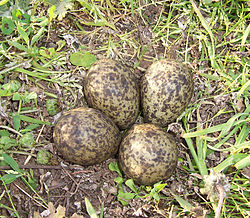
Plover
Did you know...
Arranging a Wikipedia selection for schools in the developing world without internet was an initiative by SOS Children. Click here to find out about child sponsorship.
| Plovers | |
|---|---|
 |
|
| Killdeer | |
| Scientific classification | |
| Kingdom: | Animalia |
| Phylum: | Chordata |
| Class: | Aves |
| Order: | Charadriiformes |
| Family: | Charadriidae |
| Subfamily: | Charadriinae Leach, 1820 |
| Genera | |
|
Pluvialis |
|
Plovers are a widely distributed group of wading birds belonging to the subfamily Charadriinae. There are about 40 species in the subfamily, most of them called "plover" or "dotterel". The closely related lapwing subfamily, Vanellinae, comprises another 20-odd species.
Plovers are found throughout the world, and are characterised by relatively short bills. They hunt by sight, rather than by feel as longer-billed waders like snipe do.
They feed mainly on insects, worms or other invertebrates, depending on habitat, which are obtained by a run-and-pause technique, rather than the steady probing of some other wader groups.
Species list in taxonomic order
- Eurasian Golden Plover, Pluvialis apricaria
- Pacific Golden Plover, Pluvialis fulva
- American Golden Plover, Pluvialis dominica - the American and Pacific Golden Plovers were formerly considered conspecific (as "Lesser Golden Plover"; Sangster et al., 2002)
- Grey Plover or Black-bellied Plover, Pluvialis squatarola
- New Zealand Dotterel or Red-breasted Plover, Charadrius obscurus
- Ringed Plover, Charadrius hiaticula
- Semipalmated Plover, Charadrius semipalmatus
- Long-billed Plover, Charadrius placidus
- Little Ringed Plover, Charadrius dubius
- Wilson's Plover, Charadrius wilsonia
- Killdeer, Charadrius vociferus
- Piping Plover, Charadrius melodus
- Black-banded Plover, Charadrius thoracicus
- Kittlitz's Plover, Charadrius pecuarius
- St. Helena Plover, Charadrius sanctaehelenae
- Three-banded Plover, Charadrius tricollaris
- Forbes' Plover, Charadrius forbesi
- Kentish Plover or Snowy Plover, Charadrius alexandrinus
- Javan Plover, Charadrius (alexandrinus) javanicus
- White-fronted Plover, Charadrius marginatus
- Red-capped Plover, Charadrius ruficapillus
- Malaysian Plover, Charadrius peronii
- Chestnut-banded Plover, Charadrius pallidus
- Collared Plover, Charadrius collaris
- Puna Plover, Charadrius alticola
- Double-banded Plover, Charadrius bicinctus
- Two-banded Plover, Charadrius falklandicus
- Lesser Sand Plover, Charadrius mongolus
- Greater Sand Plover, Charadrius leschenaultii
- Caspian Plover, Charadrius asiaticus
- Oriental Plover, Charadrius veredus
- Eurasian Dotterel, Charadrius morinellus
- Rufous-chested Dotterel, Charadrius modestus
- Mountain Plover, Charadrius montanus
- Hooded Plover, Charadrius rubricollis
- Shore Plover, Thinornis novaeseelandiae
- Black-fronted Dotterel, Elseyornis melanops
- Inland Dotterel, Peltohyas australis
- Wrybill, Anarhynchus frontalis
- Diademed Plover, Phegornis mitchellii
- Tawny-throated Dotterel, Oreopholus ruficollis
Many of the Charadrius species are characterised by breast bands or collars. These can be (in the adult) complete bands (Ringed, Semipalmated, Little Ringed, Long-billed), double or triple bands (Killdeer, Three-banded, Forbes', Two-banded, Double-banded) or partial collars (Kentish, Piping, Malaysian, Javan, Red-capped, Puna)

